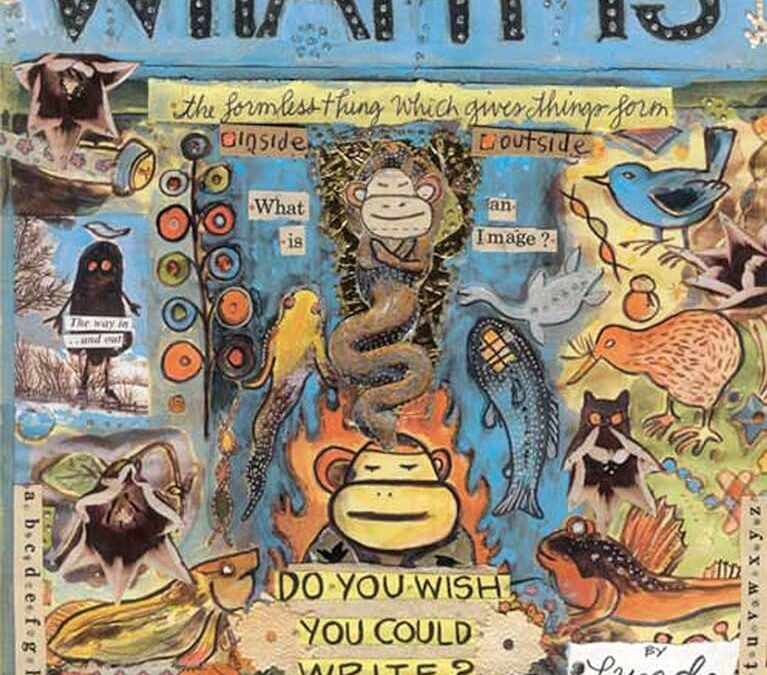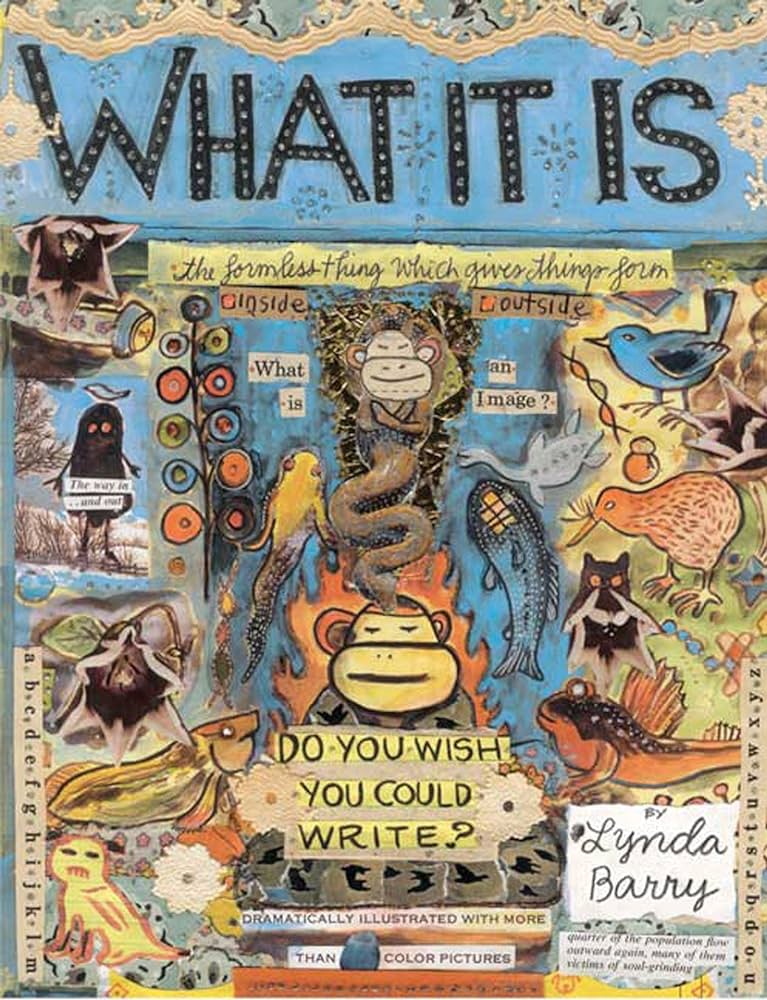 Lynda Barry’s What It Is published in hard cover in 2008 is now out in soft cover (Drawn & Quarterly, 2024). The first edition won the comic industry’s 2009 Eisner Award for Best Reality-Based Work.
Lynda Barry’s What It Is published in hard cover in 2008 is now out in soft cover (Drawn & Quarterly, 2024). The first edition won the comic industry’s 2009 Eisner Award for Best Reality-Based Work.
What It Is is a wonderful combination of a graphic novel, memoir, lots of collage, drawings, and questions to ponder as if a writing workbook with many tips to spark creativity. To many, the pages may appear chaotic but there is much to glean in this scrapbook of a life.
Comics, music and art saved her, Barry said in an interview with Tom Power on CBC Radio’s Q. Barry is an American cartoonist best known for her weekly comic strip Ernie Pook’s Comeek. She has written illustrated novels and a graphic novel called One! Hundred! Demons! which she terms “autobifictionalography.”
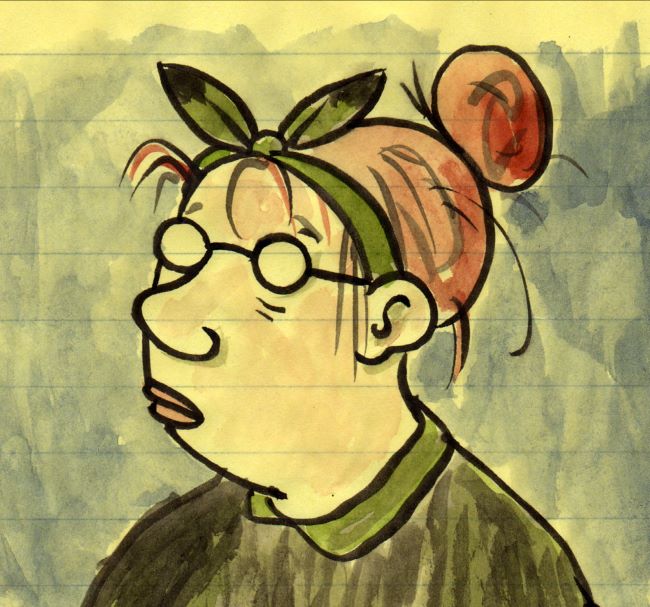 Lynda Barry by Lynda Barry
Lynda Barry by Lynda Barry
In July 2016, Barry was inducted into the Eisner Hall of Fame. She is currently an Associate Professor of Interdisciplinary Creativity at the University of Wisconsin-Madison. In 2020, her work was included in the exhibit “Women in Comics: Looking Forward, Looking Back” at the Society of Illustrators in New York City.
People think they aren’t able to draw as they can’t draw hands or a nose Barry said. In one of her You Tube videos, she shows using a symbol such as an & or # as a nose. That makes it possible and much easier!
What It Is is dedicated to Barry’s teacher Marilyn Frasca. Some pages are like a graphic novel, others are collages, many with yellow lined paper with printing and writing by Barry. Each page invites you to go deeper, between the lines and the images.
There are many questions such as What is an image? Where are images found? What is Where is your imagination? Barry’s “answers” sometimes offer more questions such as What is the past? Where is it located? Each box has an “x” beside everywhere, nowhere, somewhere, anywhere, elsewhere, here. A typewritten slip of paper says:
I know a little cupboard,
With a teeny tiny key,
Barry writes about her childhood when she wanted an imaginary friend. “My parents were not reading people. They worked, shouted, drank, slapped, belted and were broke,” she says.
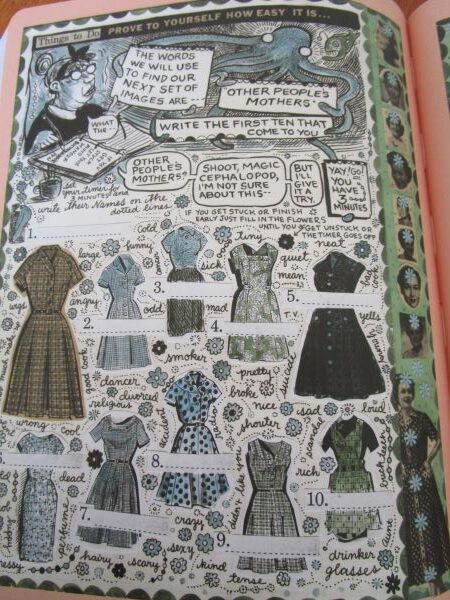 I love Barry’s down-to-earth approach. All her words and images are an invitation to explore a burning question. There just may be some further insight particularly, through the images chosen.
I love Barry’s down-to-earth approach. All her words and images are an invitation to explore a burning question. There just may be some further insight particularly, through the images chosen.
“An image feels different than thought. It feels somehow alive. If you say your first phone number outloud, you can feel something that is different than saying your phone number now,” she writes.
“We don’t create a fantasy world to escape reality, we create it to be able to stay. I believe we have always done this, used images to stand and understand what otherwise would be intolerable.”
Barry has drawn an image of her angry-appearing mother, a cigarette in her mouth, taking a copy of Grimms Fairy Tales from little Lynda (or Linda Jean as she was known as a kid). The caption reads: “No more! Give me that! Why do you read it if you know it makes you cry?”
She “started to copy pictures from storybooks and thought it would be good to make my own. I stole paper from school and made little booklets but it seemed I always would ruin them somehow.”
You may also recall ads in the backs of magazines that asked, “Do you have hidden artistic talent?” Barry’s story of copying and drawing is accompanied by her own illustrations with portraits of herself as a ten-year-old with a small bow in her hair and a Bandaid on her knee. In junior high, she copied other people’s art and especially liked to copy comics.
Why write by hand? Barry asks on one of her pages full of handwriting and printing. “There is a state of mind which is not accessible by thinking. It seems to require a participation with something. Something physical we move like a pen like a pencil. Some thing which is in motion ordinary motion like writing the alphabet. . . . “
In high school, Barry’s teacher was Marilyn Frasca, “who, in 1976 was a rather mysterious person. I studied painting with her though she never gave any technical advice beyond once showing me how to sharpen a pencil with a single edge razor blade.” Imagine a teacher smoking a cigarette, looking at your work for a long time and then saying “good”!
Barry says she could “go on trying to explain all that I learned from Marilyn, and how I accidentally became a cartoonist because of it, or I can just show you how to do it. It’s not hard. All you need is a paper and pen and a little bit of time.”
“Lessons” follow the question: “Do you wish you could write?”
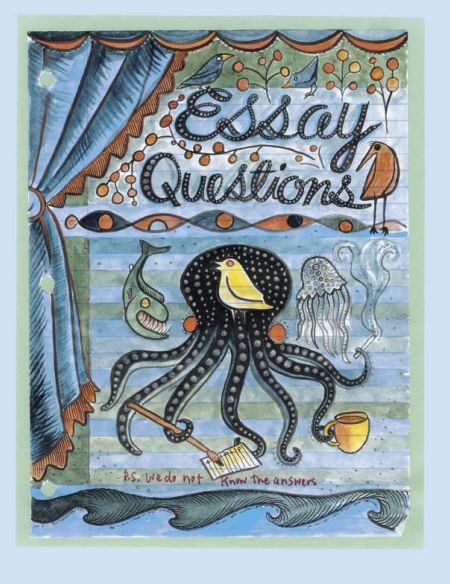 “Start with an image” is one of the pieces of advice written on the drawing of an octopus with blue eyes. Actually, it’s a “magic cephalopod.”
“Start with an image” is one of the pieces of advice written on the drawing of an octopus with blue eyes. Actually, it’s a “magic cephalopod.”
“Don’t know what we mean when we say image?” she asks on the next page. She refers again to “your first phone number.”
Another suggestion: “Make a list of the first 10 cars that come to you from early-on in your life.” Next: “Now choose one that seems vivid to you.” There are further questions to help picture the image of a car “in your mind’s eye.”
You can do the same exercise with nearly any noun Barry says. “Images are attracted to nouns! They also are drawn to verbs and gerunds!”
Imagine the fun students must have in Lynda Barry’s classes. There is fun to be had in her book as well with all sorts of prompts to get you going. She advises having a 3-ring binder and notebook paper ready.
There are several pages of words to cut out, once you’ve photocopied them. Each word is to be put in an envelope and then in a brown paper bag. “Set aside until needed when you’re ready to write.”
And don’t forget images: “Make a picture bag. Start today!” Each picture of “compelling situations, “boring situations,” and “any situations” are to be put in an envelope with the collection put in a bag.
On the last page, Barry says: ‘I owe a great deal to both Marilyn Frasca and Mark Levensky who taught a class called ‘IMAGES’ at The Evergreen State College in 1976-77 that much of this book is based on.” You can’t help but be inspired!

